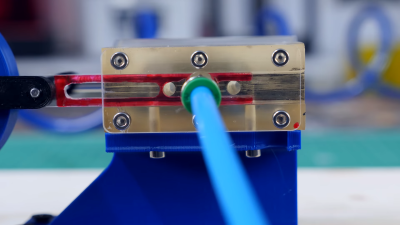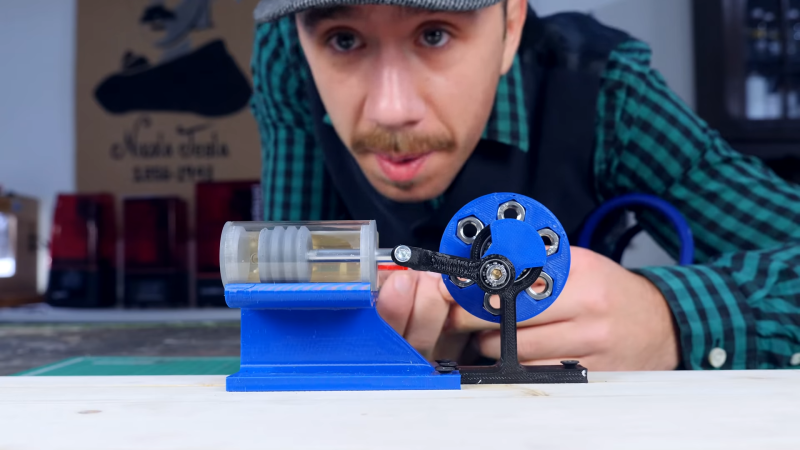3D prints aren’t typically known for their heat resistance. However, [Integza] noted that using the right techniques, it was possible to 3D print parts that could handle steam heat without failing. Thus, the natural progression from there was to build a piston-type steam engine.

Resin prints are key here, as the melting point of such parts is much higher than that of those turned out by typical FDM printers. Try this same build using PLA for the hot parts, and you’ll quickly end up with a pile of molten goo.
To make such an engine work, valves are required to allow steam to flow into alternating sides of the piston to let it reciprocate continuously. A simple slide valve is used, allowing steam to flow to one side of the piston and the other alternately, as driven by an arm coming off the flywheel attached to the engine’s output shaft.
Tested on compressed air and steam, the engine ran continuously, chugging away enthusiastically. However, steam performance was compromised by the low pressure output of just 1.5 bar from [Integza]’s pressure cooker. Similarly, the cooker’s steam capacity was low, so the engine ran for just 15 seconds.
However, it suggests that with a better supply of steam, the printed steamer could indeed run for some time. If you’re not into the wetter engines out there, though, consider extruding a Stirling engine instead. Video after the break.















But water is flammable!
(under certain circumstances) B^)
https://gizmodo.com/chlorine-trifluoride-the-chemical-that-sets-fire-to-as-1715935811
“Never drink Rose’ in Croatia, you’ll thank me later!”
B^)
I’m thinking that part of the reason the engine ran at 1.5 bar of steam better than 2 bar of compressed air; is condensing water both lubricated and sealed the piston.
Condensation also pulls a fairly strong vacuum. At 100C, 1.3cc of steam condenses to about 1 cubic millimeter of water. Engines which use that kind of boost from a phase change are called ‘Rankine’ engines because they obey the Rankine thermodynamic cycle.
Strictly speaking, steam engines use the Carnot cycle, which doesn’t allow phase changes. It takes advantage of the relationships in the ideal gas law.
Ignoring the scaling constants, the gas law is PV~T. If you heat a gas and keep the pressure constant, the volume has to increase. If you keep expanding the gas, the pressure and temperature will fall. That’s interesting because the gas doesn’t gain energy from the world around it or lose energy to the world, but the volume still increases.. a piston in the cylinder moves, doing work, without the gas gaining or losing any energy. The source of that power is entropy.. the fact that the universe prefers lower temperatures and pressures over higher ones.
The second half of the Carnot cycle works the same way in reverse: if you cool the gas at constant pressure, its volume decreases. If you keep compressing the gas, its pressure and temperature will increase.
The gas in the cylinder never needs to change.. the Stirling engine is the classic example of a Carnot engine with no exchange of working gas.
Steam engines move steam through the cylinder. In effect, they add a couple of steps between the halves of the cycle: after expanding the steam to the exit temperature, the valves let most of the cooled steam leave the cylinder. Only the remaining gas gets compressed to the input temperature and pressure. Then the valves let new steam into the cylinder for the expansion half of the cycle.
A Rankine engine uses a phase change instead of a pumping-gas-in or pumping-gas-out operations. Condensing steam to water is equivalent to removing 99.92% of the steam from the cylinder. Gasoline/deisel engines use combustion as an equivalent to pumping in a high-temperature/high-pressure gas.
The defining feature of a real heat engine is clear knowledge of the entry pressure/temperature and the exit pressure/temperature.
You can build them out of lego. There is no official kit for them, but search youtube for Lazlo Lego and watch my vids. Also join the TBLE server on discord to see even more amazing Lego Air Engines. I even sponsored a contest to build a replica in principle of the WW1 Gnome engine and by golly, they guys built a working replica of even that. There is even a working wankel rotary – all out of lego.
“the engine ran continuously”
Two sentences later:
“the engine ran for just 15 seconds”
Just sayin’
continuously doesn’t mean “perpetually”.
How many times do you think you need to say that? Maybe put it in all-caps if you feel the need to repeat.
My point is that in one sentence he implied that it would work for a reasonable amount of time, i.e., continously, and then two sentences later he says it ran JUST 15 seconds (emphasis mine), which implies that it didn’t run for anywhere near what HE would think of as ‘continuously’. Not my definition of continuous, but his.
“continuous” doesn’t mean “perpetually”. Something can run continuously for 15s – that makes sense.
Hm. Heating up a closed glass bottle with a torch, without wearing goggles. That could’ve come out a lot worse.
I remember having toys as a child which used compressed air (provided by my little hands operating the plastic pump) and you could build all kinds of things around the “engine”. my cousin an brothers and I built cranes, trucks, a boat or two; anything we could think of with an engine, we built our version, smaller, powered by compressed air just as a steam engine worked. it had two power strokes per cycle just like a steam engine. it was great. and for the life of me I cannot remember what it was called.
After googling a bit, it may have been the Tomy Air Jammer. we had more than just the car, and I seem to remember that the engine was swappable to other vehicles in the line.